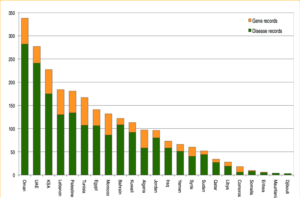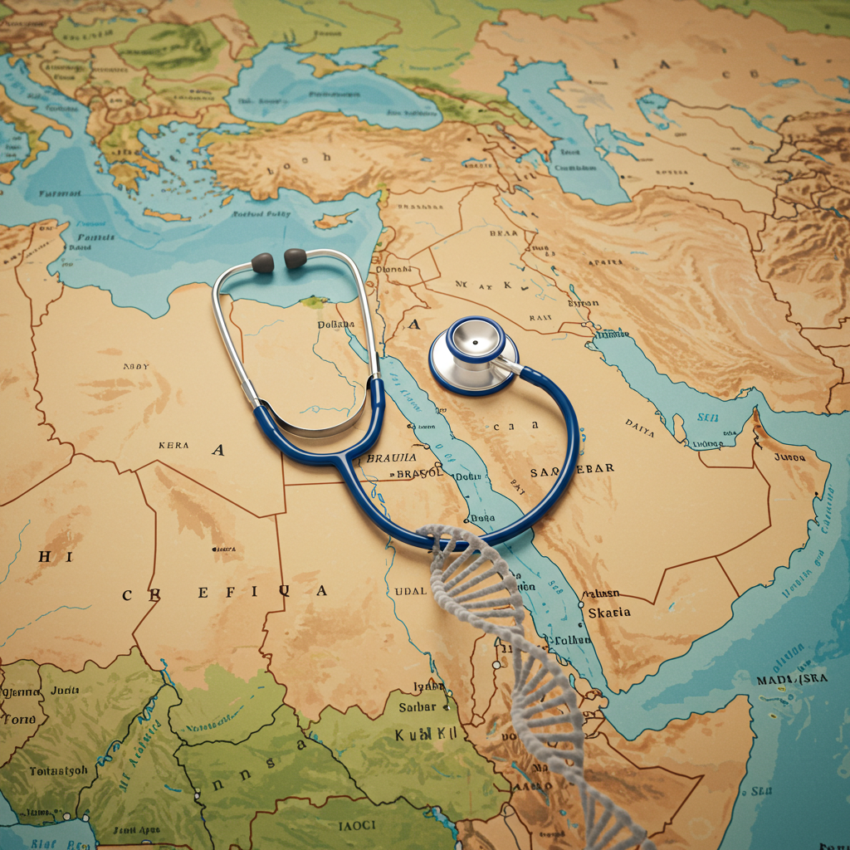Authored by: Humza Rana
Over 25 million new DNA variations, including significant alleles from the Arab demographic, have been identified. Exome research on the Saudi genome has revealed more than 3000 unprecedented nucleotide variants tied to over 1200 rare genetic conditions. The reclassification of numerous pathogenic variants in the Human Gene Mutation Database and ClinVar Database as benign through the Arab database aids in constructing a thorough and exhaustive map of the human morbid genome. Intellectual disability ranks highest, with a combined and observed carrier frequency of 0.06779 among Saudi Arabians; retinal dystrophy follows closely. Genomic studies have unveiled fascinating new candidate disease marker variations across various genes in consanguineous families. More than 7 pathogenic variants in the C12orf57 gene are significantly linked to the causation of developmental delay/intellectual impairment in Arab ancestry. Progress in extensive genomic studies provides a fresh perspective on Mendelian genes and disorders. During the last six years, candidate genes associated with intellectual disability, neuro genetic disorders, blood and bleeding disorders, and rare genetic diseases have been thoroughly documented through genomic medicine studies combined with advanced computational biology applications. The Arab metagenome revealed hundreds of variations in the mitochondrial DNA genome and ancestral connections with Africa, the Near East, and East Asia, as well as its link to obesity. These recent findings regarding disease markers and molecular genetics in the Arab population will positively influence genetic counselors in assisting consanguineous families to manage genetics-related stress and precision medicine. This narrative review encapsulates the progress in molecular medical genetics and the latest discoveries concerning pathogenic variants. Although these initiatives focus on the genetics and genomics of disorders prevalent in Arab demographics, a need for better collaboration across the projects is essential to uncover significant disease markers in the Arab population. This underscores that further exploration in genomics is crucial to fully understand the molecular irregularities and related pathogenesis driving inherited disorders in Arab ancestries.
Obstacles to Addressing Hereditary Conditions
- High Prevalence of Consanguinity
One of the primary obstacles to preventing hereditary conditions in the Arab region is the cultural prevalence of consanguineous marriages. It is estimated that approximately 20-50% of marriages in Arab countries are consanguineous, which significantly increases the risk of genetic disorders being passed on to children. These marriages are culturally accepted in many societies, where they are seen as a way to strengthen familial bonds and preserve wealth within the family.
However, consanguinity increases the likelihood that recessive genetic disorders, such as sickle cell disease, thalassemia, and cystic fibrosis, will be inherited by offspring. The close genetic relationship between parents also raises the risk of hereditary disorders such as genetic intellectual disabilities, heart conditions, and metabolic disorders.
- Limited Awareness and Genetic Counseling
Another major obstacle is the lack of awareness about the risks of hereditary conditions and genetic counseling. In many Arab countries, traditional attitudes toward marriage and family life often overshadow scientific understanding of genetic inheritance. This leads to limited public awareness about the potential health impacts of consanguineous marriages. Many families are unaware of the resources available for genetic counseling, prenatal screening, and the prevention of genetic disorders, which can contribute to the continued prevalence of these conditions. - Socioeconomic Challenges
The economic cost associated with diagnosing and treating genetic disorders can be overwhelming, especially in countries with limited healthcare infrastructure. Families affected by hereditary conditions often face a financial burden due to the long-term nature of these diseases. Many genetic disorders require lifelong medical care, which can include regular hospital visits, expensive medications, surgeries, or even specialized treatments such as gene therapy or stem cell transplants.
In countries where healthcare systems are not sufficiently developed or where access to specialized care is limited, families may struggle to afford the necessary treatments. For instance, conditions such as thalassemia or sickle cell disease require ongoing blood transfusions and medication to manage symptoms. The costs for these treatments can accumulate over time, putting a significant strain on family finances, particularly in regions where private health insurance may not fully cover the expenses.
Furthermore, the lack of specialized care and advanced treatment options in some areas exacerbates these challenges. In remote or under-resourced regions, individuals with rare genetic conditions might not have access to the medical expertise or facilities they need. This often leads to delays in diagnosis, which can worsen health outcomes and result in higher long-term medical costs.
Another aspect of socioeconomic challenges lies in the emotional and social burden on families. The continuous medical treatments can significantly affect caregivers’ ability to maintain regular employment, which in turn impacts the financial stability of households. The stigma surrounding hereditary conditions in some Arab societies may also prevent families from seeking help, further isolating them from essential resources.
Overall, the economic burden of hereditary conditions, coupled with insufficient medical care and the financial limitations of affected families, underscores the need for improvements in both healthcare accessibility and financial support mechanisms to alleviate the costs of treatment for genetic diseases.

Genetic Disorder in KSA CTGA Perspective
The clinical and genetic information collected from KSA constitutes the most extensive dataset in CTGA thus far. The distinct representation of the Saudi population concerning the occurrence and variability of genetic diseases, combined with the recent arrival of numerous new mutations, genes, and clinical manifestations, exemplifies the critical need for a free, indexed resource of genetic disorders among Arabs. It is anticipated that the CTGA will fulfill this goal by continually gathering and effectively presenting genetic information to physicians, clinicians, and researchers globally.
Data from the CTGA is crucial as it is organized geographically, encompasses information from both indexed journals and non-indexed local sources, and includes available studies on the incidence and prevalence of genetic disorders. Furthermore, the database serves as a valuable platform for fostering collaborations between regional and international researchers focused on similar fields or specific disorders.
The CTGA exemplifies the wealth of information that can be extracted and analyzed through a handful of basic searches. However, the curation of articles has faced challenges since the search process is not infallible; coupled with human error, this can lead to a considerable information gap even due to the omission of a single article. The ongoing endeavor to search for and incorporate overlooked and newly published data remains integral to maintaining the database.
It is projected that CTGA data will see substantial growth in the current era of big data, with the Saudi Human Genome Program being one example that consistently produces molecular data and prevalence studies across large patient cohorts for a diverse array of genetic disorders.
Occurrence of Hereditary Conditions in the Arab Region
The incidence of hereditary diseases varies across different countries in the Arab region. However, several genetic conditions are observed to be particularly prevalent in specific populations:
- Hemoglobinopathies (Sickle Cell Disease and Thalassemia)
Hemoglobinopathies, including sickle cell disease and thalassemia, are widespread in the Arab region. Sickle cell disease is particularly prevalent in the Gulf States, Sudan, and Saudi Arabia. Thalassemia, on the other hand, affects countries in the Eastern Mediterranean, particularly Lebanon, Egypt, and Jordan. Both of these conditions result from the inheritance of abnormal hemoglobin genes, leading to severe anemia, pain, and organ complications. - Genetic Intellectual Disabilities
Conditions such as Down syndrome, Duchene muscular dystrophy, and cerebral palsy are common in the Arab world, particularly due to consanguinity. These disorders can lead to lifelong disability and require significant medical care and social support. Advances in genetic screening and counseling have helped identify these conditions earlier, though many families still face challenges accessing proper care and resources. - Cystic Fibrosis and Rare Genetic Disorders
Cystic fibrosis, a hereditary condition that affects the lungs and digestive system, is relatively common in the Arab region, especially in countries like the UAE, Qatar, and Bahrain. Additionally, rare genetic conditions, such as metabolic disorders like phenylketonuria and Gauche disease, also occur in some populations, though these diseases may not be as widely recognized or understood.

Medical Solutions and Interventions
- Genetic Counseling and Screening
Many Arab countries are beginning to realize the importance of genetic counseling and pre-marital screening programs. Countries like Saudi Arabia and the United Arab Emirates have introduced national programs that promote genetic testing and counseling for couples planning to marry. These programs are designed to raise awareness of the potential risks of hereditary diseases and help individuals make informed decisions about their genetic health.
Genetic screening can also identify carriers of genetic diseases, enabling prospective parents to understand their risks of passing on specific conditions. In addition to prenatal screening, expanded newborn screening programs for conditions such as sickle cell disease, thalassemia, and cystic fibrosis are beginning to be implemented.
- Stem Cell and Gene Therapy
Advances in stem cell research and gene therapy offer promise for treating some hereditary conditions. For instance, gene therapy holds the potential to correct defective genes, and stem cells can be used to replace damaged tissue caused by genetic disorders. Though still in the experimental stages, these therapies have provided some hope for treating diseases that were once considered untreatable.
- Public Health Initiatives and Awareness Campaigns
Governments and healthcare institutions in the Arab world have started to launch public health initiatives aimed at reducing the burden of genetic disorders. In addition to promoting consanguinity awareness, there are efforts to increase accessibility to medical care for those with hereditary conditions. Many organizations are working to improve healthcare services, raise awareness of genetic diseases, and develop national strategies for dealing with the growing challenges posed by hereditary diseases. - Advances in Diagnostic Tools
In recent years, diagnostic tools such as whole-genome sequencing and advanced genetic testing have made it easier to identify genetic conditions early. Some countries in the region have begun to integrate these advanced technologies into routine healthcare practices, allowing for earlier diagnosis and intervention. This is crucial for providing patients with the care and treatment they need to manage genetic conditions effectively.
Conclusion
Hereditary conditions continue to present significant challenges to the Arab region, driven largely by the cultural prevalence of consanguineous marriages and a lack of widespread awareness. However, there is progress being made through genetic counseling, public health initiatives, and advances in medical research and technology. By increasing awareness, investing in genetic testing, and providing better access to medical solutions, the Arab world can take steps toward reducing the impact of hereditary conditions and improving the quality of life for affected individuals.
Q/A
What is CTGA?
CTGA (The Clinical and Genetic Atlas) is a comprehensive database that catalogs genetic disorders, with a focus on the Arab population. It serves as a crucial resource for researchers, clinicians, and healthcare professionals seeking detailed, up-to-date information about genetic diseases in the Arab world. The CTGA aggregates clinical and genetic data from various sources, including indexed journals, non-indexed local publications, and regional studies, making it a valuable tool for the understanding of hereditary conditions specific to this population.
The database is organized geographically and covers a broad range of disorders, their incidence, prevalence, and genetic underpinnings. One of its primary objectives is to serve as a global reference for genetic disease information, especially for clinicians and researchers focused on rare or region-specific genetic disorders. By consolidating genetic data, the CTGA helps to promote international collaborations, enabling better research outcomes, early diagnosis, and more effective treatment of genetic conditions.
Sources
- Heterogeneity in biomarkers, metagenome and genetic disorders of the Arab population with special emphasis on large-scale whole-exome sequencing
- Genetic Disorder in KSA
